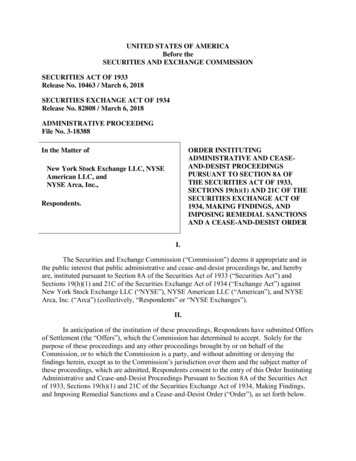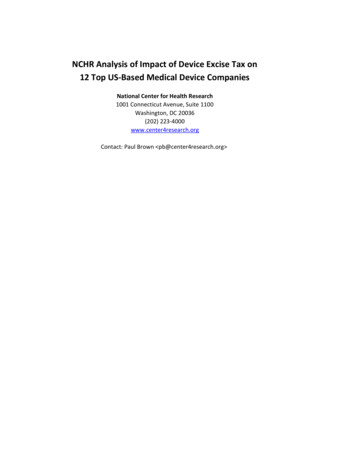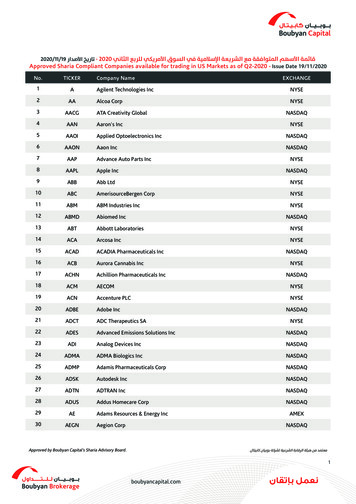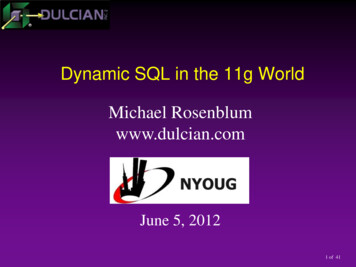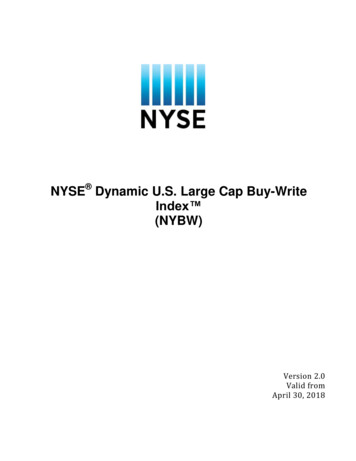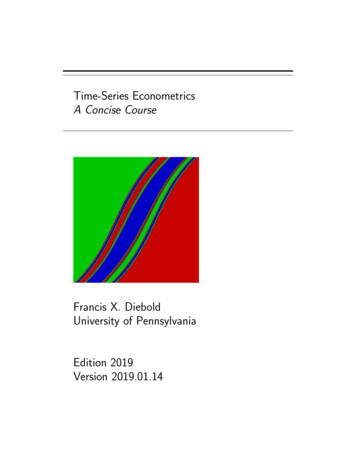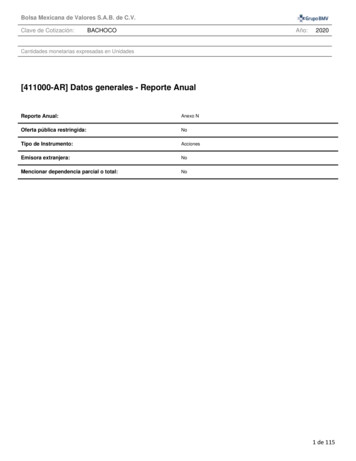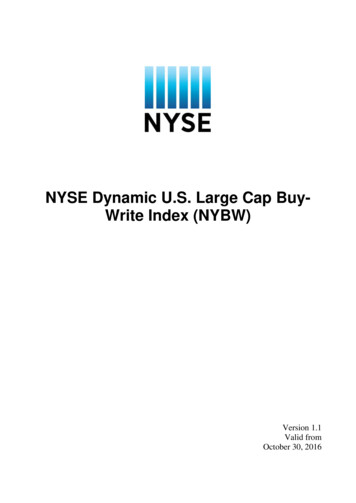
Transcription
NYSE Dynamic U.S. Large Cap BuyWrite Index (NYBW)Version 1.1Valid fromOctober 30, 2016
Table of contentsVersion History:.11. Index summary .22. Governance and disclaimer.33. Publication .43.1 The opening, intraday and closing or daily publication of index values. .43.2 Exceptional market conditions and corrections .53.3 Announcement policy .54. Calculation .74.1 Calculation of the price index .74.2 Currency Conversion .75. Index reviews .85.1 General aim of reviews and frequency .85.2 Index selection and weighting principles .86. Corporate Actions .106.1 General .106.2 Removal of constituents .106.3 Dividends .106.4 Bonus issues, stock splits and reverse stock splits .106.5 Changes in number of shares .117. Index Formula .127.1 Index calculation formula .12Version History:Version 1.1 (Effective October 30, 2016)This version was released to incorporate name change to NYSE Dynamic U.S. Large Cap BuyWrite Index (NYBW) and change reference time for 50 DMA and 200 DMA to 9:00am ET.Version 1.0 (Effective October 15, 2015)This version was released to support the launch of a new index, the NYSE Enhanced Buy-WriteIndex (NYBW).1
1. Index summaryFactsheetIndex TypesNYSE Dynamic U.S. Large Cap Buy-Write Index (NYBW)Total Return: NYSE Dynamic U.S. Large Cap Buy-Write Index(NYBW)Index DescriptionThe NYSE Dynamic U.S. Large Cap Buy-Write Index (NYBW)measures the total rate of return of a hypothetical covered call strategyapplied to the SPDR S&P 500 ETF (SPY). This strategy consists of ahypothetical portfolio consisting of a long position in SPY upon whichsuccessive one-week SPY call options are sold each week.Eligible ComponentsSPDR S&P 500 ETF (SPY)SPDR S&P 500 ETF (SPY) weekly call optionsNumber of Constituents(2) - SPDR S&P 500 ETF (SPY) / SPDR S&P 500 ETF weekly calloptionFull NamesEffective Date of theWeekly ReviewThe index will always maintain 100% exposure to the SPDR S&P 500ETF (SPY), with an equivalent notional amount being written in a SPDRS&P 500 ETF weekly call option.Conducted based upon SPDR S&P 500 ETF (SPY) 50- and 200-DayMoving Averages as of 9:30 AM ET on each Friday - If there is a U.S.equity markets holiday, then the review is conducted on the prior tradingday - If there is an early closing at 1:00 PM ET for the U.S. equitymarkets, then the review is conducted at 11:00 AM ET on that dayReallocation to the newly determined SPDR S&P 500 ETF (SPY)weekly call option is conducted based on the VWAP of the old and newcontracts between 2:30 and 3:30 PM ET, or, if an early closing day forthe U.S. equity markets, between 11:30 AM and 12:30 PM ET –Resulting gain or loss from options roll is reinvested into SPY at theofficial closing price from the same weekly review dayCalculation FrequencyTotal Return: 15 seconds between 09:30 & 18:00 ETBase DateOctober 9, 2015Base LevelHistoric Data AvailableSince1000.00WeightingWeekly Review ofCompositionJune 30, 2010Derivatives and LinkedProductsBloomberg CodeNYBW INDEXReuters Code.NYBWLaunch DateOctober 15, 20152
2. Governance and disclaimerIndex Sponsor & Calculation AgentNYSE Group, Inc. is the Index Sponsor. NYSE Arca is the Index Calculation Agent onbehalf of NYSE Group, Inc.The NYSE Arca Index Committee is responsible for the day-to-day management of the indexand is also responsible for decisions regarding the interpretation of these rules. The IndexCommittee reviews all rule book modifications and index constituent changes to ensure that theyare made objectively and without bias. NYSE Arca believes that information regarding rulebook modifications and index constituent changes is material and can have an impact on themarket. Consequently, all index committee discussions and decisions are confidential.The index was developed in association with T3 Index, a research-driven financial indexing firmspecializing in volatility and options benchmarking.Cases not covered in rulesIn cases which are not expressly covered in these rules, operational adjustments will take placealong the lines of the aim of the index. Operational adjustments may also take place if, in theopinion of the calculation agent, it is desirable to do so to maintain a fair and orderly market inderivatives on this index and/or this is in the best interests of the investors in products based on theindex and/or the proper functioning of the markets.Rule book changesThe Index Committee reviews all rule book modifications and index changes to ensure that they aremade objectively and without bias. These rules may be supplemented, amended in whole or in part,revised or withdrawn at any time. Supplements, amendments, revisions and withdrawals may alsolead to changes in the way the index is compiled or calculated or affect the index in another way.LiabilityNYSE Arca is not liable for any losses resulting from supplementing, amending, revising orwithdrawing the Rules for the index. The calculation agent will do everything within its power toensure the accuracy of the composition, calculation, publication and adjustment of the index inaccordance with relevant rules. However, NYSE Arca is not liable for any inaccuracy in shareprices, calculations and the publication of the index, the information used for making adjustmentsto the index and the actual adjustments. Furthermore, NYSE Arca does not guarantee nor thecontinuity of the composition of the index, nor the continuity of the calculation of the index, nor thecontinuity of the dissemination of the index levels.Ownership and trademarksIntercontinental Exchange, Inc. (ICE) owns all intellectual and other property rights to the Index,including the name, the composition and the calculation of the Index. NYSE , NYSE Arca andNYSE Group, Inc. are registered trademarks of ICE’s subsidiaries.3
3. Publication3.1 The opening, intraday and closing or daily publication of index values.OpeningThe first index level is calculated and published around 09:30 ET, when the U.S. equity marketsopen for their regular trading session. The calculation of that level utilizes the most updated pricesor quotes available at that moment. In the case of the SPDR S&P 500 ETF (SPY) having a nontraded, halted or suspended status, or not having opened for the current day, the previous day’sprimary exchange official closing price is utilized. In the case of the SPY weekly option having ahalted or suspended status, or not having opened for the current day, the previous day’s referenceprice is utilized (the 4 PM bid/ask midpoint).Dissemination frequencyThe level of the index is in principle published every 15 seconds to the NYSE Global Index Feed(NYSE GIF). The calculated index levels incorporate the latest traded price of the SPDR S&P500 ETF (SPY) and the latest bid/ask midpoint of the SPY weekly options contract from within theregular trading session, normally 09:30 to 16:00 ET. Intraday calculations of the index wouldincorporate SPY trades and SPY weekly option quotes on a consolidated level, from all exchangesincluding those not designated as the official primary exchange.The index is calculated from 09:30 until 18:00 ET on those days specified as index business days.Index business days will be classified as days on which the U.S. Equity Markets (NYSE ,NASDAQ, NYSE MKT) are open for a full or partial day of trading. On most days, the indexclose will be available shortly after 16:00 ET.Closing levelThe closing level is the last level disseminated on the trading day and uses the official close pricefrom the primary listing market for the SPDR S&P 500 ETF (SPY), NYSE Arca. If SPY has anon-traded, halted or suspended status, or has not opened for the current day, the previous day’sprimary exchange official closing price is utilized instead.The closing index level also utilizes the 4 PM bid/ask midpoint for the SPY weekly optionscontract. In the case of the SPY weekly option having a halted or suspended status, or not havingopened for the current day, the previous day’s reference price is utilized (the 4 PM bid/askmidpoint). In the case of exceptional market conditions, the Index calculation agent reserves theright to utilize other prices in the calculation of the official closing level, as indicated below inSection 3.2.Sources of DataThe Consolidated Tape (CTS/UDTF) is the primary market data source for U.S. equity realtime andclosing prices. The Options Price Reporting Authority (OPRA) feed is the primary market data4
source for U.S. options realtime and closing quotes. Additional sources of data less commonlyused include other market data vendors, company announcements, exchange announcements, andother official sources.3.2 Exceptional market conditions and correctionsThe calculation agent retains the right to delay the publication of the opening level of the index.Furthermore, the calculation agent of the index retains the right to suspend the publication of thelevel of the index if it believes that circumstances prevent the proper calculation of the index.If index constituent prices are cancelled, the index will not be recalculated unless the calculationagent decides otherwise.Commercially reasonable efforts are made to ensure the correctness and validity of data used inreal-time index calculations. If incorrect price or corporate action data affects index daily highs,lows, or closes, it is corrected retroactively as soon as possible.There is the possibility of an exchange or market-wide event resulting in the normal closing auctionnot going off or official closing prices not being available. In those situations, the index will takeguidance from the respective exchange(s) and address on an event-by-event basis. Exchange ormarket-wide events include, but are not limited to, the following:o Volatility Halts LULD (Limit Up / Limit Down) Market Wide Circuit Breakero Technological Problems / Failureso Natural Disaster or Other BCP-Related EventPlease note that in the case of an LULD (Limit Up / Limit Down) halt near the close, there is still aclosing auction, and Arca produces an “M” sales condition otherwise, which is disseminated viafeeds or other methods to the public.3.3 Announcement policyAnnouncement policyChanges to the index composition or methodology will be announced by an index announcementwhich will be distributed via www.nyxdata.com and ftp2.nyxdata.com.As a general rule the announcement periods that are mentioned below will be applied. However,urgently required corporate action treatments, often resulting from late notices from the relevantcompany or exchange, may require the calculation agent to deviate from the standard timing.Inclusion of new constituentsThe inclusion of a new short position in a SPDR S&P 500 ETF (SPY) weekly call option within theindex will typically only occur during the weekly reviews. The inclusion of that new optionscontract will be announced after the determination time (typically 2 PM ET) on the effective date of5
the actual inclusion. For example, for the weekly review effective for October 16, 2015, theannouncement would occur after 2 PM ET on that same day, October 16, 2015.Removal of ConstituentsThe removal of a short position in a SPDR S&P 500 ETF (SPY) weekly call option within theindex (buying it back) will typically only occur during the weekly reviews. The removal of thatnew options contract will be announced after the determination time (typically 2 PM ET) on theeffective date of the actual inclusion. For example, for the weekly review effective for October 16,2015, the announcement would occur after 2 PM ET on that same day, October 16, 2015.Corporate actionsIn case of an event that could affect one or more constituents, the calculation agent will inform themarket about the intended treatment of the event in the index shortly after the firm details havebecome available and have been confirmed. When possible, the corporate action will be announced,even if not all information is known, at least one trading day before the effective date of the action.Once the corporate action has been effectuated, the calculation agent will confirm the changes in aseparate announcement.Rule changesGoing forward, barring exceptional circumstances, a period of at least two months should passbetween the date a proposed change is published and the date it goes into effect. Exceptions can bemade if the change is not in conflict with the interests of an affected party, which specificallyincludes external parties that license the index for a tracking product.6
4. Calculation4.1 Calculation of the price indexThe index is calculated on a Total Return basis. The current index level would be calculated bydividing the current modified index market capitalization by the index divisor. The divisor wasdetermined off of the initial capitalization base of the index and the base level. The divisor isupdated as a result of corporate actions and composition changes.The Total Return calculation incorporates regular cash dividends for the SPDR S&P 500 ETF(SPY) paid and reinvests those distributions back into the ETF before the open on the ex-date.4.2 Currency ConversionThe index is calculated and published in USD. The index calculation agent reserves the right tocreate, calculate, and publish the index in other currencies as required.7
5. Index reviews5.1 General aim of reviews and frequencyGeneral aim of the weekly reviewThe general aim of the weekly review of the index is to ensure that the selection and weighting ofthe relevant short SPDR S&P 500 ETF (SPY) weekly call option continues to reflect as closely aspossible the index’s goal of intelligently selecting a strike price depending on the expected move inthe SPY ETF price, while trying to maximize the premium received. The calculation agentreserves the right to, at any time, change the SPY weekly call option shorted, if in the calculationagent’s discretion such substitution is necessary or appropriate to maintain the quality and/orcharacter of the index.FrequencyChanges to the SPDR S&P 500 ETF (SPY) weekly call option occur once a week on either Friday,or, if not an index business day, the prior trading day. The exact SPY weekly call option to beshorted is determined at 9:30 AM ET and the writing of the option is conducted off of the VWAPbetween 2:30 and 3:30 PM ET. The corresponding gain or loss from the roll of the option isreinvested back into SPY at the primary exchange official closing price of that weekly review day.On days where the U.S. equity markets close early due to holiday, all times above would be shiftedearlier by 3 hours.5.2 Index selection and weighting principlesWeekly ReviewThe weekly review process is conducted as follows:1. The weekly review date is determined as either the Friday of the week, or, if not an indexbusiness day, then the prior trading day. All times laid out below would be moved up by 3hours if that day is an early closing day for the U.S. equity markets due to holiday.2. At 9:30 AM ET, the 50-day and 200-day moving averages are calculated for the SPDR S&P500 ETF (SPY). The moving averages utilize dividend- and split-adjusted closing pricesto remove the effect of distributions. They also include the SPY price as of 9:30 AM ET onthe day of the weekly review. For all other days, the official primary exchange officialclosing price is utilized.3. The choice of which SPDR S&P 500 ETF (SPY) weekly call option to sell is based on asimple moving average crossover rule, which is a well-understood indicator of whether themarket is likely to rise or fall and has been analysed for many decades.4. If the 50-day moving average is lower than the 200-day moving average, suggesting themarket is likely to go down, then the call option with a strike price closest to 98% of the9:30 AM ET SPY last trade is selected.8
5. If the 50-day moving average is higher than the 200-day moving average, suggesting themarket is likely to go up, then the call option with a strike price closest to 102% of the 9:30AM ET SPY last trade is selected instead.6. The options roll occurs at the VWAP (volume-weighted average price) of both the outgoingand incoming options between 2:30 and 3:30 PM ET.7. The short position in the expiring SPY weekly options contract that the index has exposureto is bought and closed out based on this VWAP price.8. A new short position in the next-week SPY weekly options contract at the strike asdetermined above is written, also based on the VWAP logic above.9. The number of contracts of the relevant SPY weekly option to be written is determined withthe goal of selling it against the total value of the index portfolio as of 9:30 AM ET,including the long SPY position and the short SPY call option. The number of contracts isdetermined by dividing the notional value of the portfolio by the SPY last trade as of 9:30AM ET, all divided by the option multiplier, which is always 100.10. The resulting gain or loss from the closing out (buying back) of the expiring SPY weeklyoption and writing (selling short) of the new SPY weekly option is used to adjust the SPYshares held within the index, effective after the close and based off of the SPY primaryexchange official closing price on that day. (primary exchange being NYSE Arca)11. Since SPY options expire on Friday afternoons, selling the new weekly position on Fridaywill result in the portfolio holding a naked short call position for a period of time. Toprevent that from happening, the strategy will simultaneously buy back the expiring calloptions while selling new options for the next expiration date. Hence the index iseffectively rolling the short call position forward.9
6. Corporate Actions6.1GeneralThe index may be adjusted in order to maintain the continuity of the index level and thecomposition. The underlying aim is that the index continues to reflect as closely as possible theindex’s goal of intelligently selecting a strike price depending on the expected move in the SPYETF price, while trying to maximize the premium received.Adjustments take place in reaction to events that occur with constituents in order to mitigate oreliminate the effect of that event on the index performance.6.2Removal of constituentsThe SPDR S&P 500 ETF (SPY) position within the index will never be removed from thecomposition. The relevant SPY weekly call options position will be removed every week, as partof the regular weekly review and rolling process.6.2.1 Price sourcesIn the event that the trading in shares is suspended or halted, the last known price of SPYestablished during regular daytime trading on the primary exchange will be used. Depending onthe particular situation, the Index Calculation agent may choose to value the SPY ETF or SPY ETFweekly call option at a custom, evaluated price for purposes of index calculation and/or weeklyreview and roll. This would be applicable for certain extreme cases and would be assessed as theyarise.6.3Dividends6.3.1.Distinction ordinary and special dividendThe main total return index will be adjusted for dividends in SPY that are both regular and specialin nature, typically through a price adjustment and corresponding share increase in that SPYposition. The reinvestment occurs before the open of trading on the ex-date of the dividend. Thedivisor will be adjusted to account for any changes in the overall index market capitalization.6.4Bonus issues, stock splits and reverse stock splitsFor bonus issues, stock splits and reverse stock splits, the number of shares included in the indexwill be adjusted in accordance with the ratio given in the corporate action. Since the event will alsoincorporate a corresponding price adjustment and won’t change the value of the company includedin the index, the divisor will not be changed because of this.10
6.5Changes in number of sharesChanges in the number of shares outstanding of SPY, typically due to creations or redemptions,will not be reflected in the index.11
7. Index Formula7.1 Index calculation formulaThe general formula for the main total return version of the Index is: 1 Index t Pi, t Qi, t O t D t i Where:tmeans Index Calculation Date tDt means the Index divisor on Index Calculation Date tPi,t means the price of Index Constituent i (SPY) on Index Calculation Date tQi,t means the number of shares of Index Constituent i (SPY) on Index Calculation Date tOt means the current gain or loss of the SPY weekly options position on Index CalculationDate tIndex Calculation Date means a U.S. Business Day where all the U.S. equity markets are open.For the total return version of the Index, the number of shares of SPY are adjusted before theopen of each Index Constituent’s ex-date to take into account the reinvestment of the relateddividend.For any currency variant of the Index, the current USD level of the Index will be multiplied bythe ratio of the current USD FX rate divided by the USD FX rate as of the Index base date.12
The NYSE Dynamic U.S. Large Cap Buy-Write Index (NYBW) measures the total rate of return of a hypothetical covered call strategy applied to the SPDR S&P 500 ETF (SPY). This strategy consists of a hypothetical portfolio consisting of a long position in SPY upon which successive one-week SPY call options are sold each week. Eligible Components
